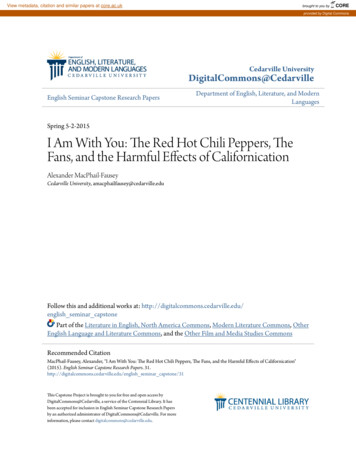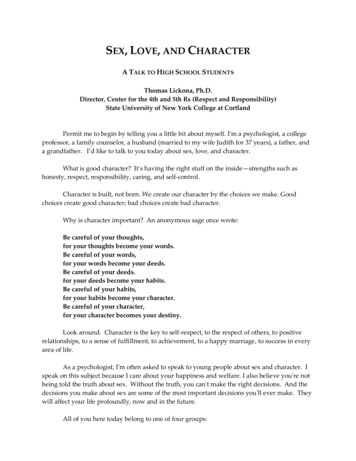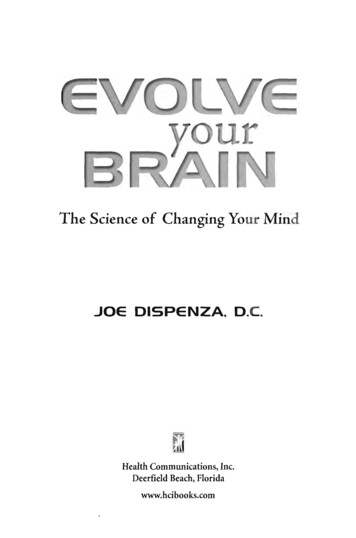
Transcription
View metadata, citation and similar papers at core.ac.ukbrought to you byCOREprovided by Digital CommonsCedarville UniversityDigitalCommons@CedarvilleEnglish Seminar Capstone Research PapersDepartment of English, Literature, and ModernLanguagesSpring 5-2-2015I Am With You: The Red Hot Chili Peppers, TheFans, and the Harmful Effects of CalifornicationAlexander MacPhail-FauseyCedarville University, amacphailfausey@cedarville.eduFollow this and additional works at: http://digitalcommons.cedarville.edu/english seminar capstonePart of the Literature in English, North America Commons, Modern Literature Commons, OtherEnglish Language and Literature Commons, and the Other Film and Media Studies CommonsRecommended CitationMacPhail-Fausey, Alexander, "I Am With You: The Red Hot Chili Peppers, The Fans, and the Harmful Effects of Californication"(2015). English Seminar Capstone Research Papers. 31.http://digitalcommons.cedarville.edu/english seminar capstone/31This Capstone Project is brought to you for free and open access byDigitalCommons@Cedarville, a service of the Centennial Library. It hasbeen accepted for inclusion in English Seminar Capstone Research Papersby an authorized administrator of DigitalCommons@Cedarville. For moreinformation, please contact digitalcommons@cedarville.edu.
I Am With YouThe Red Hot Chili Peppers, The Fans, and the Harmful Effects of CalifornicationAlexander MacPhail-FauseyDeardorffSenior Sem8 April 2015
MacPhail-Fausey 1One of the Red Hot Chili Peppers’ most recent projects is a book of photographs titledFandemonium . David Mushegain, the photographer for the book, paired with the Peppers toshow the fans that “they weren’t just another face in the crowd” (Mushegain 39). The bookfeatures the stories of over one hundred individual fans from the 2011-2013 I’m With You tour.In his introduction to the book, Anthony Kiedis, the lead singer and lyricist for the Peppers,explains his connection to the band’s fan base. He writes that the fans were attracted to thePeppers’ authenticity, unlike the “posers” in the popular hair metal bands who were simplyputting on a show (21). The Peppers were a band to which the audience in California couldrelate. Kiedis writes that the bands atmosphere “made people feel like, ‘Oh, I can talk to theseguys. There’re just knuckleheads like me” (21). Since the beginning of their career, the Peppershave had a special relationship with their fans, and this essay will argue that the Peppers usedCalifornication to reach an audience harmed by Hollywood’s influence on the American Dream.However, before engaging the album, it is important to understand how postmodernismaffected the history of celebrity and the American Dream. According to Val Rust,postmodernism claims that humans no longer possess the ability to attach ultimate meaning towords, arguing against the modernist thought that there is a “universal, international style”(Rust 611). This idea is further explained by Jean Baudrillard, who argues that culture hasobliterated nature, especially through replacing reality with signs (Baudrillard 1557). He beginsby explaining the loss of the transcendent signified. With a god figure as a metanarrative, signswere stable and thereby represented reality. However, with the death of religion during theEnlightenment, humans have lost the capacity for a single stable sign (1559). He argues for
MacPhail-Fausey 2symbolic order where the sign, or any thing, is comprised of two parts. The signifier, which isthe word representing the sign, and the signified, which is the thing itself.Baudrillard's first level of symbolic order states that when signs are stable, no onedoubts the meaning behind the sign, and art reflects a basic reality. However, he would arguethat, as a result of postmodernism, there are no more stable signs, and therefore the symbolicorder has been steadily decreasing in its realness. Thereby, the second level is when art masksor perverts a basic reality (Baudrillard 1560). This level occurred between the Renaissance andthe beginning of the Enlightenment eras. However, the Enlightenment gave way to the nextlevel, which progressed to the modern period. This is when art masks the absence of a basicreality. Finally, once society moved into the postmodern, art bears no relation to reality at all(1560).Katherine Hayles expands Baudrillard’s theory of signs, and explains why the sign ismore unstable after the popularity of the internet in the 1990s. Hayles examines Lacan and LeviStrauss’ theory of the floating signifier. As humans have moved through time, the sign hastransitioned from one stable narrative to several somewhat unstable narratives, similar toBaudrillard’s symbolic order. This comes as a result of an increase in images with theintroduction of mass media, like the television in 1950’s America. The images are floatingbecause they change at regular intervals, and the individual has the ability to choose whichimages to believe and which to ignore (Hayles 2165-2171).However, with the rise of the internet, Hayles argues for a transition to the flickeringsignifier. Signs have moved from floating to flickering because, where the previous images werehanging in the air, the new images appear and are immediately discredited by the next image.
MacPhail-Fausey 3Since information travels quickly across the internet, it only takes a moment for the meaning ofone image to be lost to the next (Hayles 2178). Thereby, the definition of human is lost to thepower of the flickering signifier.Finally, Michel Foucault examines how power vectors influence individual thought.Foucault focuses on the influence of government authority on the institutionalization ofprisons. He examines how the power vectors influence individual thought. Originally, disciplinecame through an open system of punishment, where the collective community would decidewhether or not to punish a person. Then, the community would also choose the punishment.Thereby, punishment had a clear purpose. Eventually, society institutionalized discipline in aclosed system of punishment. This is the introduction of the carceral system, where police areused to enforce laws established by power vectors. Criminals are placed in prisons, where theycan be observed at all times. Foucault terms this constant observation the panoptic (Foucault1491-1502). However, within the context of Hayles’ flickering signifier and the postmoderninfluence on the American Dream, Foucault’s theories on the influence of power vectors canalso apply to the authority of the media.Anthony Oberschall examines this connection between Foucault’s panoptic and themedia. Oberschall connects mass media to “the full glare of publicity,” which he also calls “the‘whole world is watching’ phenomenon” (Oberschall 280). His argument that the atmosphere ofthe demonstration changes when the whole of society is observing it echoes Foucault’s theoryof the panoptic. He explains that “The presence of a camera transforms a demonstration”(280). People take more chances when the press is present because they know their actions will
MacPhail-Fausey 4be observed by the entire world, showing that the constant watch of the media influences thepublic (280).He notes that the authorities also became victims of the panoptic. As the public watchesthe news coverage, although the power vectors controlling the media are not explicitly beingobserved, the vectors’ preferences become apparent. Thereby, when the authorities single outmedia stars for prosecution, “they ended up adding to their [the media stars] stature andprovided a rallying point for the opposition” (281). Society then sees how the power vectorsmanipulate the media, and attempts to combat that control.Oberschall then connects Foucault to Hayles’ flickering signifiers when he examines howthe media is pressured to provide “instant coverage, analysis, and commentary in the contextof the highly competitive communications industry” (280). This instant coverage causescontradictions between the information provided, as the news constantly shifts between sidesof the conflict, each trying to discredit the other. He writes that “media exposure was a rapidand cheap way of mobilizing a following and of drawing a response from target groups” (282).With an understanding of these theories on postmodernism and the influence of the media, it ispossible to understand how Hollywood affects the American Dream and celebrity status.In the early 1900s, celebrity status entered human history, originating in New York and,more prominently, Hollywood. This system of celebrity grew until, by the late twentiethcentury, celebrities had come to expect “obsequious deference, exact significant financialtribute, and lay claim to legal privilege” (Kurzman 347). This expectation correlates with MaxWeber’s work on social groups. Weber asserts that “status is a group characteristic” creating“an autonomous social hierarchy” produced by the society as a whole (Kurzman 348). High
MacPhail-Fausey 5status is defined by “a specific style of life ,” and thereby use this style of life to limit entry intotheir status (348-349). Weber claims that those in high-status “usurp” this recognition andstatus from the lower-status groups, through gaining a certain economic class and legalprivilege (349). Finally, through limiting contact with people of lower status, they enforce thedifferentiation between themselves and the common.However, within contemporary society a new status system has developed outside ofWeber’s theory, the system of celebrity. Within this system, the boundaries between high andlow status are uncertain, “with members of the highest-status groups being whisked in and outevery year,” much like Hayles’ flickering signifiers (Kurzman 352). Celebrity status has “acquireda new significance in the era of mass media,” as images and information pass rapidly (352).These flickering images are demanded by audiences, and thereby solidify the need for celebritywithin contemporary society (353). Unlike previous status groups, celebrity is “a creature ofcapitalism” (353). They arise from the “commodification of reputation,” promoted primarilythrough the introduction of the public relations industry, which sculpts the image of celebrity tofit the demands of society (353). As Horkheimer and Adorno noted, the culture industry usescelebrity to distract society from the power vector behind the media, and “measures itsinterchangeable starlets solely by their box-office earnings” making all of their performancesadvertisements for the industry (353).Most significantly, the shift in celebrity toward the end of the 20th Century marks theinfluence of postmodernism and the flickering signifier on the status group. Andy Warholpredicted, “In the future everyone will be famous for fifteen minutes,” and later changed theline to “In fifteen minutes everybody will be famous” (354). For the current era, Warhol’s
MacPhail-Fausey 6prediction is seemingly accurate. Now, celebrity status requires a “constant recruitment of newmembers” because the demands of society change so quickly (354). These demands havecaused an increase in the number of individuals seeking to gain their fifteen minutes.This celebrity status has also led to the creation of a cult of celebrity. As soon as thecelebrity status arose in society, stars began to appear in everyday life, with advertisements,newspapers, and magazines. The increase in the prominence of the star is directly linked withthe growing popularity of the film industry. Samantha Barbas writes how celebrities hadbecome educators the the general public of America, teaching “concrete lessons in personality,style, and good grooming” (Barbas 36). These celebrities, then, promoted the expandingconsumer culture through the advertising industry. Thereby, celebrities were creating theimage of personality which was deemed ideal (Barbas 52).Barbas concludes her chapter “The Cult of Personality” by examining the Hollywood cultof celebrity. American pop culture was revolutionized by the “merger of movies and modernity”(Barbas 56). The growth of urban society led to more emphasis on performing skills thancharacter, and society looked toward Hollywood to determine those skills. This is howcelebrities became “America’s ideal models of personality” (56). Barbas writes that the culturalimpact of this new cult of celebrity was enormous. Society as a whole began revolving aroundHollywood, to the point where the media regularly reported on celebrity life (57). This focus onthe celebrity created a new fan culture, to whom “worshipping a star meant not only watchingher films, but buying the items she endorsed, the styles she wore, and the magazines thatchronicled her latest adventures,” thereby perpetuating the cult of personality (57).
MacPhail-Fausey 7Michael Coyne further explains the cult of celebrity. He comments that “stars are placedsomewhere “between gods and heroes” (Coyne 430). However, although the stars are idolized,he notes that they fill a “unique American cultural need” (430). Society needs celebrity as muchas celebrity is dependent on the culture industry. Therefore, society thrives on following the“social and family background, personal temperament and any marked discrepancy betweenstar image and private actuality” (430). This cult of celebrity is defined by Fowles’ theory thatsociety is dependent on the stars. He explains Hollywood’s construction of “a Great Life,” whichis the lifestyle created by the stars which effectively standardizes the construction of celebrity(431). He writes that “Hollywood’s treatment of a given historical personage was as likely tostructure its narrative by borrowing from other movie lines which had previously struck gold” toexplain how, through attempting to meet the demands of society, the culture industry willrecycle material until the concept of celebrity is standard and universal across all spheres (431).However, Daniel Harris argues that the cult of celebrity affects the celebrities. Popculture, and much of high culture “thrive on myths of untutored genius,” believing that artistsdon’t need to undergo training, but rather are born with the natural skill (Harris 623). The socialbodies of the celebrities, are thereby dictated to act in accordance with the “mythology ofgenius” (623). The weight of being determined to not need practice tends to drive stars’ livesout of control, leading to drug and alcohol addiction. Yet, this loss of control is not onlyaccepted, it’s expected of celebrities, because culture dictates that the genius must live atroubled life (623). This permissiveness of “their self-destructive misconduct” as a guarantee oftheir authenticity as geniuses “ultimately leads to their high rate of mortality” (623-624).
MacPhail-Fausey 8Then, Hollywood also affects the the concept of the American Dream. Lawrence Samuelexplains that this dream was first named during the Great Depression. At that time, the dreamwas “a chicken in every pot and a car in every garage,” but it has since changed into theacquisition of “a golf course viewed through the picture window” (Samuel 42). When the termwas birthed, it was defined as, “The dream is a vision of a better, deeper, richer life for everyindividual, regardless of the position in society which he or she may occupy by the accident ofbirth” (13). However, the American Dream “splintered and fragmented in the postwar years” asthe nation became more complex (42). During the Depression, the dream meant the ability toprovide for oneself and one’s family, but in the prosperity of postwar America, it blossomedinto “virtually any situation involving aspiration or achievement” (43). Thereby, the AmericanDream became a focus on acquiring a certain status within society. Within the 1950’s society,the dream became a focus on commercial products. The American Dream was owning thelatest appliances and having the appearance of wealth. This same time period saw the rise ofcelebrity taking a hold on the culture industry. Babe Ruth, in the thirties and forties, became anicon of the American Dream, but he was celebrated in 1958 (54). He gained fame through beingthe best at baseball, but was idolized because of his wealth and his “fondness for fast cars (andfast women)” (55). Most importantly, however, Ruth was raised in an orphanage, showing thatanyone could accomplish the dream.Samuel argues that the constant shift in the meaning of the American Dream displayedone consistent theme. This was that the dream promoted the acquisition of a certain status. Inorder to acquire the material goods expected in the dream, one required access to wealth.
MacPhail-Fausey 9According to Samuel, this wealth was always accompanied with status, whether that becelebrity, or simply the attainment of Weber’s high-status (Samuel 62-63).Dick Meyer, then, connects Samuel’s explanation of the American Dream with theinfluence of the cult of celebrity. The values of the United States are found in the politicalsystem of the nation, and on the American Dream, which, as seen in Samuel’s text, has lost atrue definition. Therefore the foundation of American society is unstable. Subsequently, Meyerargues that American culture has filled itself with the “business of the self” (Meyer 70). Heblames the culture of narcissism defined by Christopher Lasch for producing this focus onfeeling. Lasch wrote, “What a man does matters less than the fact that he has ‘made it’” (71).This status is the end goal of the “American Way,” attaining the wealth and fame accompaniedby celebrity (72). The American people want to emulate celebrities until they become them.However, Meyer seems to contradict himself near the end of his book. With a theory hecalls the “Character Gap,” Meyer argues that Americans are unable to trust celebrities, becausethey are expected to have character traits that don’t match their social status. Celebrities,according to the rules of society, should be considered in the high class of the status groupsbecause of their wealth and limited contact with the general public (206). However, as Meyerpoints out, celebrities tend to have personalities which cause them to act outside the of highstatus. As a result, these figure heads of society, acting against the status they are supposedlypromoting, fill the American public with distrust. However, the public, under the influence ofthe cult of celebrity, are still influenced to mimic the stars (207).Yet, this mixture of celebrity and the American Dream influenced the culture ofCalifornia, and, more specifically, Los Angeles. Kenneth Marcus writes that “the recording and
MacPhail-Fausey 10radio industries helped define modern entertainment in Los Angeles” (Marcus 163). He explainshow the large number of radio stations not only reflected the demand for radio, but also helpedproduce a “radio culture” in which recording artists sought to bring together “virtualcommunities of listeners who enjoyed a variety of music” (163). Marcus writes that radiobroadcasting paved the way for Los Angeles to become the center of the entertainmentindustry which would later be defined by the growth of film.Michael Fallon comments that L.A. has become the cultural capital of California. L.A., as“the richest, healthiest, most admired urban area in the United States,” embodies the“California Dream” (Fallon 1). This dream is fame, wealth, and happiness, all of which the citypromises. As the influence of Los Angeles grew, it eventually spread into areas of art historicallycharacterized as “the territory of Eastern [American] establishments,” namely theatre, dance,music, literature, and visual art (2). In his book, Fallen explores how California eventually cameto dominate these fields of art.However, Fallon argues it was the seventies in which the artists were struggling todefine the meaning of art. He writes how the artists of the seventies transitioned the art scenefrom a focus on “dominant group narratives,” to “a fragmented ‘society of spectacle,’” showingthe movement toward postmodernism and Hayles’ theory of the flickering signifier (Fallon 309).The art culture allowed almost anything as “there was no returning to the singular and heroicart narratives of the past” (341). In this new atmosphere, anyone had the potential to rise tothe top. Fallen explains how the term “Appropriation” came to dictate the art scene in theseventies (314). Appropriation had to do with the influence of Baudrillard, who is noted to havegained “five minutes” of fame for his theory of simulacra (314). Through the disassociation of
MacPhail-Fausey 11image with meaning, the generation of artists in the seventies would leave the 1980’s with thedisillusionment of the California Dream (342). However, the artists who rose during theseventies, and into the early eighties, found that their art impacted the culture of California.This impact came through redefining art to fit into the new context of art without a grandnarrative (342).Within this context, Blackie Dammett, the stage name of John Michael Kiedis, left hisfamily in Michigan and moved to Los Angeles. He hoped to pursue the American Dream throughacting, and as previously stated, Hollywood was the space to find that success. However, inorder to chase this dream, he had to leave his wife Peggy Idema and their son Anthony Kiedis.After Dammett left, Idema and Kiedis had a difficult home life, leading Kiedis to move to LosAngeles with his father when he was twelve. When he left, he told as his friends he was goingto be a movie star, already showing the cult of celebrity obsession of status (Kiedis 25). Once inCalifornia, his father exposed him to the artistic culture of Los Angeles. At the same time thatKiedis had his first joint, at the age of twelve, his father had him take pictures of a naked girl,but had added that it “might be more artistic if you just had her expose one of her breasts”(27). This was the kind of relationship Kiedis had with his father and with California culture. Hewas learning that drug use and art of all kinds went hand in hand. His father, an attemptedactor, spent most of his time high on drugs. As a result, Kiedis found a role model in SonnyBono, someone who had already achieved the celebrity status (29). When his father’s actingcareer wasn’t paying bills, Dammett turned to selling cocaine and prescription narcotics.In high school, Kiedis became friends with Michael Balzary (Flea), Jack Irons, and HillelSlovak, who would later become the first lineup of the Red Hot Chili Peppers. After they
MacPhail-Fausey 12graduated, they realized college wasn’t for them, and decided to form a band. Slovak and Ironswere already in a somewhat successful band named What Is This? (Apter 125). However,through an accidental need for a singer during a performance, Kiedis got up and rapped someof his poetry and thus the Red Hot Chili Peppers began, originally as Tony Flow and theMiraculously Majestic Masters of Mayhem (60).Slovak and Kiedis were best friends, and eventually began getting and taking herointogether. Kiedis remarks that Slovak was “a late bloomer to drugs” (Kiedis 83). Kiedis however,had started heroin around the time of his short stay at college. Kiedis recalled a time when, ontour with the Peppers, he and Slovak had promised to quit heroin (221). Their next gig was inOslo, after they played the show, they flew home, and Slovak died of a heroin overdose. Kiedis,then, did the only thing he knew how to do, and went and got more heroin. He writes, “Youdon’t want to deal with your own wreckage, you just want to keep getting high” (223). Slovak’sdeath was the inspiration for the Peppers’ song “Under the Bridge,” which gained the bandfame in mainstream music (Apter 151). Eventually, Kiedis went to rehab and got off the heroin.However, the band had to find a replacement guitarist.This is when Kiedis met John Frusciante. Frusciante was a fan of the Peppers, and hadmemorized all of their songs on the guitar. After Slovak’s death, the band’s decision to add theeighteen year-old was only logical, because, he not only knew the songs, he had the funk thePeppers needed. However, after helping with the album Blood Sugar Sex Magik, Kiedis writesthat Frusciante “didn’t know how to live in tandem with that creativity” and started usingheroin (Kiedis 280). His addiction continued to worsen, just like Kiedis’ or Slovak’s, until heeventually quit the band in 1992. He left because he couldn’t get rid of “the voices in his head
MacPhail-Fausey 13(his “spirits”)” (Fitzpatrick 101). He had fallen into serious heroin addiction, to the point wherehe’d lost his teeth and a lot of his hair (100). Frusciante, who had decided to constantly takeheroin and cocaine because they were the only way he could be happy after he quit the band,not only lost his health, but also most of his guitar skill from the absence.However, he couldn’t stay away forever. Six years after he quit, he returned, afterhaving nearly died from heroin addiction. Kiedis remarks that “I didn’t want to see him die a sadand miserable death,” remembering his previous experience with Slovak (Kiedis 397). However,the band needed to make some changes to bring Frusciante back into the band. Frusciante andKiedis had a terrible relationship near the time Frusciante quit the band in 1992. Apter notesthat Kiedis had become self-absorbed and just completely ignored Frusciante on stage.Frusciante recalled that “it was always that Flea and Anthony were at odds with each other andI was always friends with one of them,” but all three could not be friends at the same time(Apter 301). When he and Frusciante finally talked about their problems with each other Kiedissays, “I thought we should probably go over all this stuff, but I don’t feel bothered by itanymore” (Kiedis 398). This tense relationship makes Kiedis’ recollection of the restoration ofhis and Frusciante’s friendship in Scar Tissue more impactful. However, when the band decidedto let him play again, “it was so funky, that I [Kiedis] don’t think I’ll ever experience that feelingever again” (Fitzpatrick 101).Frusciante rejoined the band in 1997, and in 1999, the Red Hot Chili Peppers releasedtheir seventh studio album, Californication . The album was the band’s highest grossing, sellingover 12 million copies. Kiedis, Flea, and the the rest of the band had all begun changing theirindividual characters during the writing and after the production of Californication . Mirit Eliraz
MacPhail-Fausey 14examines the character of the individual band members around this time. He quotes Flea, whoexclaimed that “[Kiedis] has really shed his ego and is much more considerate of the worldaround him” (Eliraz 204). Eliraz calls this the “inner search” on which the band embarked duringtheir work on the album, and he notes that “their mutual bond has grown stronger as a directresult of these efforts” (204). Thereby, Eliraz argues that Kiedis recognized the harmful natureof californication through his interaction with Frusciante.Steven Van Wolputte defines the act of californication as a "dominant ideology [that]promotes looking young and beautiful as a way of being healthy, successful, and morally right,”and this identity “is considered conterminous with lifestyle, a commodity to be purchased”(Wolputte 264). In his article "HANG ON TO YOUR SELF: Of Bodies, Embodiment, and Selves,”he examines the difference between the physical body and the social body, claiming the twobodies are interdependent. The physical body effects the social, and yet itself only beingexperienced through social terms. The social body, then, is only a symbol. Yet, it restricts theactions of the physical body (253). Van Wolputte, then, relates the body and space. He arguesthat, in order for the body to even become a social construction, it must first be associated witha space. Spatial ordering “fits the symbolic and social order,” meaning that space is theinteraction between text and context (253-254). Here he argues that social interaction is“riddled with contradiction and conflict” which is shaped by the dominating ideologies of thespace within which those social orders are found (254).Within the context of the social and spatial body, Van Wolputte proposes a logicaldefinition of californication, as the society dictating how the body should look and act. Thisdictation becomes synonymous with success and moral character, influenced heavily by the
MacPhail-Fausey 15media and the depictions of celebrities, specifically in Hollywood. However, this influence ofcalifornication on the body in contrast with the individual self raises “the awareness offragmentation and multiplicity brings with it a stronger emphasis on an ideology that denies it”(264).Yet, Van Wolputte’s definition of californication only focuses on the physical appearanceand how that plays into the social ideologies. The Peppers, both through the albumCalifornication and their individual lives, show how the social space and the influence ofCalifornia has affected their identities, thereby affirming Van Wolputte’s analysis. However, thePeppers redefine californication as a compound word composed of California and fornication,to expose how the Hollywood culture and the pursuit of the American Dream has “fucked,” orharmed, both those rejected and accepted by celebrity, and use that definition to connect withthe audience affected by californication.The song, “Californication,” as the title track, provides a basis for the Peppers’ definitionof the act of californication. At the beginning of the song, Kiedis describes a few types of peoplewho move to California looking for success, the “Psychic spies” and the “Little girls fromSweden” (“Californication” 1-4). These dreams, to gain the recognition of the general public,are what Kiedis uses in the first stanza to define californication. This idea reflects Foucault’stheory of
The Red Hot Chili Peppers, The Fans, and the Harmful Effects of Californication Alexander MacPhail-Fausey Deardorff Senior Sem 8 April 2015 . MacPhail-Fausey 1 One of the Red Hot Chili Peppers’ most recent projects is a book of photographs titled Fandemonium . David Mushegain, the photographer











